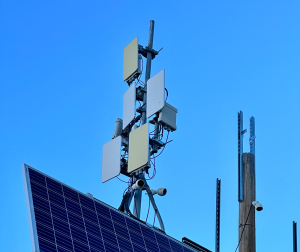Wider, faster, private 5G
October 4th, 2023

5G not only promises faster access to the Internet for mobile users but also other benefits for businesses. For example, factory automation, robotic delivery systems, and communications with agricultural devices such as smart tractors could use private 5G wireless networks.
Achieving the highest possible speeds requires the wide bandwidths available at extremely high frequencies (EHF). The range of these millimetre wavelength (mmWave) signals is limited. But mmWave operation is ideal for mobile services in areas with high populations densities and for localised private networks in, for example, factories.
Ofcom, the telecoms regulator in the UK, has recently announced their plans for the allocation of bandwidth at 26 GHz and 40 GHz for 5G provision in both high density and low density areas.
Licence provision is complicated by the need to avoid interference with existing applications using EHF including microwave point to point connections. However, licences in the UK for 26 GHz fixed link services in and around high-density areas will be withdrawn in the next five years.
Two types of 5G licence will be available: 15 year term licences for city and town wide provision of 5G mobile services will be auctioned while licences for more localised services in both high and low density areas will be offered on a first come, first served basis at a fixed fee. There is a limit on the number of transmitters and power constraints for localised services especially in or near high density areas.
Regulators in the UK, Germany, Sweden, the Netherlands, and Switzerland are also issuing or planning to issue licences for localised, private services at lower frequency bands such as 3.7 GHz.
You can learn more about 5G services and operation by studying PTT online courses such as Introduction to mobile systems, 4G and 5G radio access networks, and Advanced mobile systems.
Or, for a complete picture, why not take advantage of our special offer to celebrate PTT’s 30 years of learning provision and study all of the PTT courses covering mobile communications.
Comments Off on Wider, faster, private 5G
Challenges of full-fibre deployment
September 18th, 2023

Deploying full fibre connections to customer premises has long been a challenge for service providers.
These challenges can include infrastructure costs. Building a fibre optic network is expensive, with providers needing to lay many miles of cable, often causing unwanted disruption to the local population with the necessary construction work. The initial capital expenditure can be significant and take years to recoup.
Another challenge is increased competition in the market, with new entrants especially facing intense competition. Established providers might lower prices or offer incentives to retain customers, making it challenging for newcomers to gain market share. With pressures on the cost of living, customers are attracted by cheaper offers and the same time as expecting increasingly fast and reliable connections.
Yet another issue facing service providers is technological obsolescence. Even though full-fibre connections are relatively future-proof, providers must continually upgrade and maintain their networks to keep pace with changing customer expectations, traffic growth, security concerns, and emerging technologies in the ever-evolving telecommunications industry.
5G networks or even satellite internet are also seen as viable alternatives to fibre to the premises. Many service providers in the future will provide customers with these alternative connections with 5G fixed wireless access offering almost fibre-like speeds without the need to put cables to customer properties.
PTT has a wide range of courses covering fixed and wireless networks. Organisations can be assured that PTT courses can provide their staff with up-to-date content on modern communications networks, enabling them keep on top of ever evolving technologies and customer expectations.
Comments Off on Challenges of full-fibre deployment
Out with the old, in with the new
September 4th, 2023

The telecommunications industry has gone through many changes in its history from telegraphic messages in the 1830s to high-speed access to the Internet in the 2020s. But the rate of change from a technological viewpoint has significantly increased in this century.
Mobile communications in particular has been subject to major changes in capabilities and infrastructure. The second generation of mobile systems were first deployed in the 1990s while the third generation came in the early 2000s. Now operators already have plans to retire their earlier systems and replace them with 4G and 5G networks. For example, Digi Communications has recently announced it has shut down its 3G network in Romania. The UK plans to phase out 2G and 3G by 2033 but some UK operators including Vodafone and EE has revealed plans to phase out 3G by 2024.
Meanwhile, TDC NET in Denmark has implemented its first Standalone 5G (5G SA) mobile service having launched a non-standalone service three years ago. Vodafone launched its 5G SA service in several UK cities in June of this year.
5G SA does not rely on a neighbouring 4G (LTE) network and can therefore provide the eco-system required for new innovative services.
PTT offers a range of online courses that will keep you up-to-date with telecoms technological changes including those covering 4G and 5G mobile systems.
For individual users, to celebrate our 30th anniversary, we are offering 30% off our bundle of 5 online courses covering mobile and wireless networks and services.
Comments Off on Out with the old, in with the new


